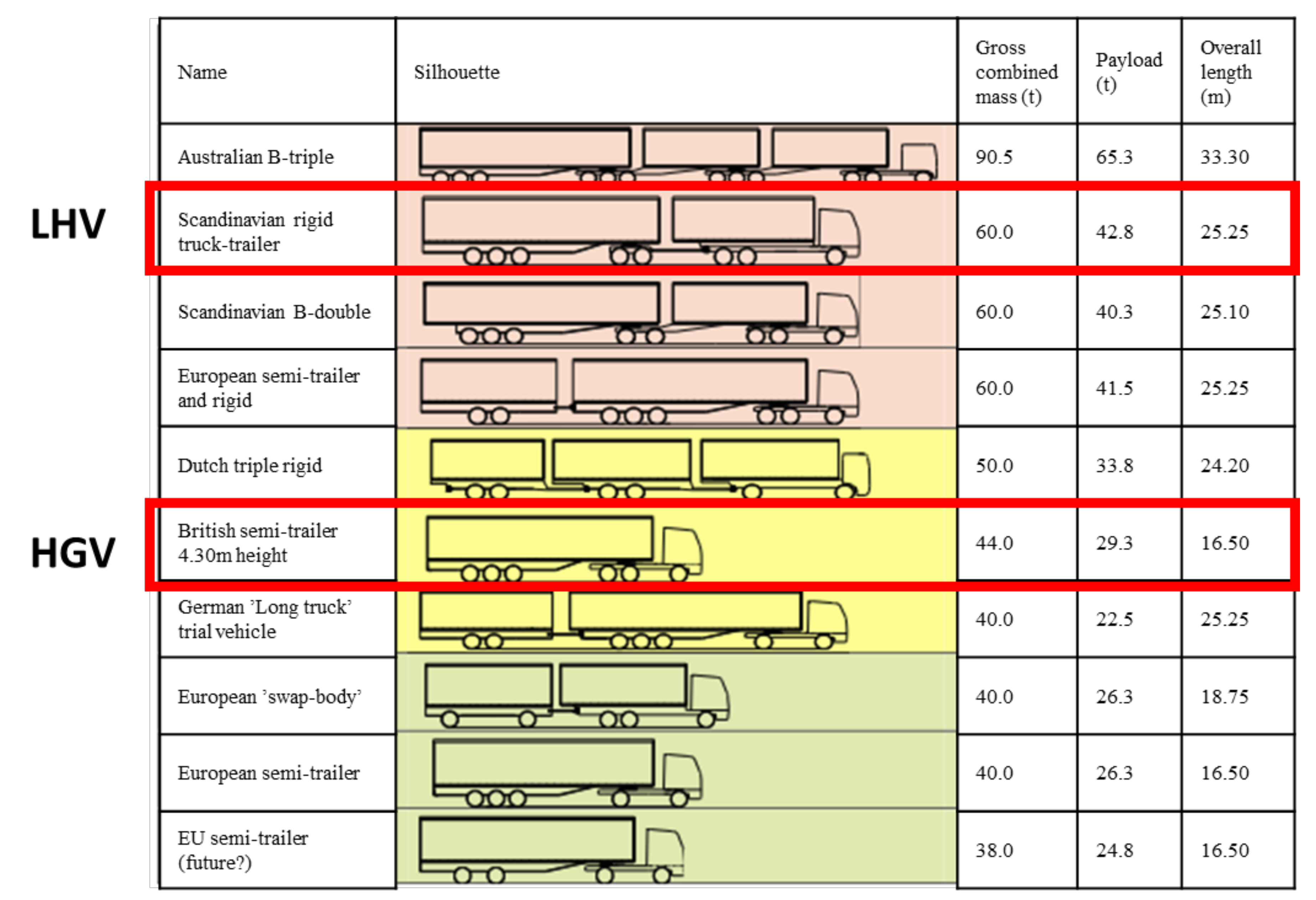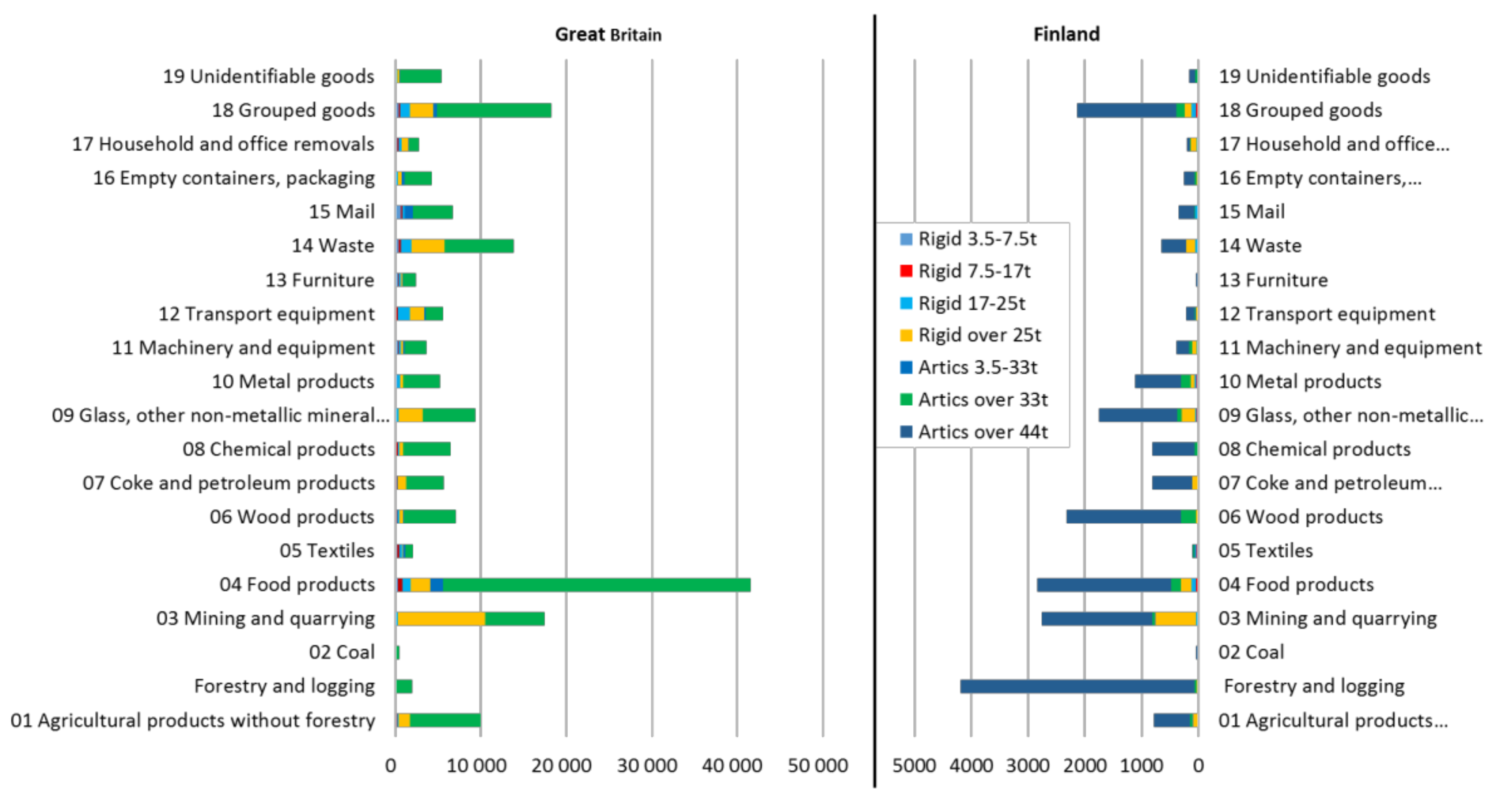Road freight transport contributes significantly to global greenhouse gas emissions and its importance is likely to increase in the future as passenger vehicles may be electrified more easily and the energy sector increasingly utilises renewable energy sources in order to mitigate climate change. Hence, greenhouse gas emissions, particularly carbon dioxide (CO
2) emissions, from road freight should also be reduced. Various possible measures to achieve emission reductions in road freight have been identified and analysed both nationally (e.g., [
1]) and internationally (e.g., [
2]). Measures can be broadly catergorised using the ASIF framework to avoiding journeys (A), modal shift (S), lowering transport energy intensity (I), and reducing carbon intensity of fuels (F) [
2]. One of the most effective ways to avoid journeys and reduce energy intensity per unit of payload transported of road freight, resulting in reduced CO
2 emissions, is to increase the size of road freight vehicles. Provided their payload capacity is fully utilized, larger vehicles are always significantly more fuel efficient per tonne of payload than the smaller vehicles they replace [
3].
1.1. Long and Heavy Vehicles (LHVs)
Lorries are used in various tractor-trailer combinations around the world from over 30-m long Australian B-triple vehicles with 90t gross vehicle weight (GVW) to European semitrailer combinations with 16.5 m length and 40t GVW (
Figure 1). Also, the height of the vehicles varies from 4 m to 4.8 m of British double-deck semitrailers. Semitrailer vehicles are commonly, as well as in this study, referred to as heavy goods vehicles (HGVs), while the 25.25 m long vehicle combinations are commonly referred to as long and heavy vehicles (LHVs). LHVs may have various maximum gross vehicle weights and trailer combinations following the European modular system (EMS). In this study, LHVs mean the Scandinavian rigid truck–trailer combination with 60t GVW and HGVs mean the British semitrailer with 44t GVW and generally 16.5-m length, although there are currently also 18.75 m semitrailers on British roads due to the on-going ‘longer semitrailer trial’ (
https://www.gov.uk/government/collections/longer-semi-trailer-trial).
High-capacity, multiply-articulated long and heavy vehicles (LHVs) are routinely used in Scandinavian countries, the Netherlands, Germany, as well as Australia, Canada, South Africa, and the USA because of their superior productivity and low CO
2 emissions per tonne-km. Such vehicles typically have 20–30% lower fuel consumption and CO
2 emissions per unit of freight transport than their conventional tractor–semitrailer counterparts [
4].
Finland has vast experience of the use of LHVs. Vehicles of 25.25 m in length with a maximum gross vehicle weight (GVW) of 60 tonnes have been in use since 1993 and currently, 78% of tonne-kilometres are carried using LHVs [
5]. These vehicles have typically been a combination of a three-axle rigid truck and a four-axle full trailer, but other combinations within the European modular system (EMS) have also been used. In October 2013, the maximum GVW was increased to 76 tonnes for nine-axle vehicles and 68 tonnes with eight-axle vehicles. This has caused a significant shift from seven-axle vehicles to eight- and nine-axle vehicles, and led to around 3.5% savings in truck vehicles kms and €100 million savings in transport costs in 2016 [
6]. Given the long history of LHVs in Finland, it can provide valuable information on the actual utilization of LHVs in the freight transport sector, if those would also be allowed in the United Kingdom.
1.2. Possible Impacts of LHVs Based on Literature
Long and heavy vehicles have been a subject of strenuous political debate in Europe during the 21st century. Particularly during 2008 to 2010, several policy reports were published addressing the issue on both a national and European level [
7,
8,
9]. “A Review of Megatrucks” [
3] highlighted the key findings from eight of these studies and stated that “there is widespread agreement that LHVs would reduce operating costs of road freight and greenhouse gas emissions per tonne-km of goods transported”. Most research also agrees that vehicle mileage, transport costs, and emissions of road freight transport will be reduced on company level and also on national aggregate level if LHVs are introduced, or that these would increase if the LHVs currently in operation in countries such as Finland, Sweden, Canada, and Australia would be replaced with standard heavy goods vehicles [
3,
10,
11,
12,
13].
Some desk study reports argue that LHVs would result in major modal shift from rail to road, which would outweigh the efficiency gains within road freight transport and lead to an increase in CO
2 emissions [
8,
9]. Opposing evidence to these desk studies exist and Steer et al. [
3] conclude that “empirical evidence is difficult to find with regards to many of the primary concerns regarding LHVs… where empirical evidence is available, it tends to show… lower modal shift”. McKinnon [
14] presented evidence supporting that of Steer et al. [
3] from the United Kingdom when the maximum weight of HGVs was raised to 44 tonnes. It was estimated that increasing maximum weight of HGVs to 44 tonnes would reduce rail freight tonne-kms by 10%. However, the market share of rail freight remained fairly stable at 11% [
14].
More recent research from Spain did not consider modal shift because “the market share of domestic freight rail transportation in Spain is so low that any transfer would be negligible” [
15]. In a German survey, “77% of the respondents did not foresee a shift of the existing freight traffic from rail to road”, while 55% expected that the road freight transport market would see higher growth than expected if LHVs would be adopted [
11]. A study in Belgium concluded that “the impact of LHVs on the geographic market area of intermodal terminals can be substantial if road transport prices would decrease by up to 15 or 25%”, but “it would be necessary to study the goods flows that actually qualify for a reverse modal shift to LHVs, not only based on price, but also on other logistics requirements” [
10]. Overall, the evidence on modal shift remains inconclusive. Hence, a sensitivity analysis taking into account possible modal shift is included in this study.
In addition to possible modal shift, worries about LHVs’ effect on infrastructure and safety have been raised. Steer et al. [
3] conclude that LHVs may induce additional capital and maintenance costs for infrastructure, but these can only be assessed nationally. Ortega et al. [
15] estimated the required investments in Spain from 150 to 1000 million euros, depending on the extent of road network on which LHVs would be allowed. Ericson et al. [
16] estimated that road wear costs would decrease by €14–20 million if Sweden would give up LHVs and use the HGVs instead. Generally, the road wear of pavement decreases when moving from HGVs to LHVs [
4], but there might be negative effects on the substructure of the road [
17] and increased investment needed in road bridges [
18].
Regarding the safety effects of LHVs, Glaeser and Ritzinger [
4] show that LHVs have worse performance in terms of ratio of amplification of lateral acceleration of the tractor unit compared with trailer and total swept width is larger, which indicate that LHVs are more difficult to manoeuvre and thus may have greater risk per vehicle. However, Steer et al. [
3] conclude that there is no evidence of increased safety risk and reduction in vehicle-kms may even outweigh increased risk per vehicle. Leach et al. [
13] also see no significant impact in the United Kingdom and Ortega et al. [
15] say that sensitivity costs of accidents are negligible in Spain if LHVs are introduced. During the ongoing trials with longer semitrailers (trailer length 15.65 m instead of 13.6 m) in the United Kingdom, the trial vehicles have been involved in 70% fewer personal injury collisions than average articulated HGV [
19], but this could be because better than average drivers have likely been selected to the trial and trial vehicles may not have been used similarly to average HGVs.
The effects of LHVs have been studied on company level [
11,
12]; on sectoral level, typically focusing on intermodal transport sector [
10,
13,
20]; and on national level [
14,
15], reports reviewed by the authors of [
3], while international studies have been limited to technical comparison of various types of LHVs [
4] and an overall study across Europe [
7]. Ortega et al. [
15] highlight that there is a lack of sensitivity analysis, which would identify the influence of the kind and amount of freight that would use LHVs and the percentage of empty running. Meers et al. [
10] also conclude that accounting for product characteristics and the corresponding transport quality requirements would enable estimations in greater detail.
In order to fill these research gaps, the purpose of this study is to assess the impacts of long and heavy vehicles on various commodities in the United Kindom based on the Finnish experiences. The two countries are quite different in terms of the importance of various sectors on economy and freight transport needs, hence it is necessary to evaluate the use of LHVs on the greatest level of detail available, that is, on commodity level. Each commodity can be seen to have similar logistics practices and types of goods carried are similar between countries. This enables conclusions on the suitability and uptake rate of LHVs to be drawn in the United Kingdom based on Finnish experiences. Specifically, the research question to be answered in this study is the following: What are the possible savings in road freight transport vehicle kilometres, costs, and CO2 emissions in the United Kingdom, if LHVs were introduced and used similarly to Finland in the transport of various commodities?







